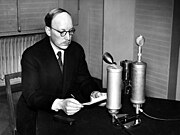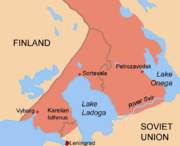Ryti-Ribbentrop Treaty
With the Ryti-Ribbentrop declaration of consent ( Finnish: Ryti-Ribbentrop-sopimus ) of June 26, 1944, the cooperation between the Republic of Finland and the German Reich turned into a formal military alliance during the Second World War .
content
With the treaty, the then Finnish President Risto Ryti undertook not to conclude a separate peace with the Soviet Union in the Continuation War , except with the express consent of the German Reich. The agreement was the result of negotiations by the Nazi Foreign Minister Joachim von Ribbentrop , who unexpectedly arrived in Helsinki on June 22nd .
The agreement was approved after careful scrutiny by Marshal Mannerheim and the War Cabinet, but it was passed off as Ryti's personal endeavor in order to intentionally avoid the form of a binding treaty between the governments of Finland and the German Reich, which would have required the Finnish parliament to be involved.
fail
From a Finnish point of view, the agreement became obsolete when Ryti resigned as president on July 31 and Mannerheim became his successor. At the request of the chief of the OKW , Field Marshal Wilhelm Keitel , Mannerheim informed the Germans that he and Finland were in no way bound by Ryti's declaration of consent.
Finland concluded an armistice with the Soviet Union within six weeks . The ceasefire conditions provided for the German Wehrmacht to be driven out of northern Finland by force of arms, which resulted in the Lapland War .
rating
In retrospect it turned out that the importance of the Ryti-Ribbentrop Treaty for the further course of the war had been clearly overestimated in June 1944. The Wehrmacht had already delivered urgently needed anti-tank weapons and dispatched a significant number of bomber squadrons to support the defense of the Karelian Isthmus . In fact, all the necessary military aid was probably already in Finland or on the way there when Ribbentrop put pressure on President Ryti - so the German Foreign Ministry and the OKW seem to be working past each other. Before the Soviet summer offensive in 1944, it is estimated that the Finnish army tied at least 26 divisions , 5 brigades and 16 regiments of the Red Army . The Finnish armed forces were therefore of great use to the Wehrmacht, with their dedicated defense of the Finnish homeland from a communist invasion to cover the German withdrawal from Russia - and later also the Baltic States .
On the other hand, the German Foreign Office on Wilhelmstrasse wanted to take advantage of Finland's precarious situation (after the Soviet fortress Vyborg was taken) by tying military aid deliveries to political concessions. Ryti and Mannerheim were not aware of the conflict of competence between OKW and Wilhelmstrasse; besides, the risk was too great that in the end Ribbentrop's ministry might persuade the armed forces to stop supporting Finland completely.
Historical background
Finland experienced a turbulent time in the first half of the 20th century . Both Russian expansion plans and the October Revolution had tarnished the previously good Russian-Finnish relations. The Finnish civil war with its bloody aftermath, the Åland crisis , the expansionist rhetoric and the military expeditions in Russian Karelia, the passionate anti-communism and the Mäntsälä uprising of the semi- fascist Lapua movement with connections in the highest Finnish circles led to cool and later also hardly improved relations with the other Scandinavian countries .
An attempted cooperation between the states (" border states ") that had become independent in the course of the collapse of the Russian Empire and the Soviet Union did not materialize. By the intervention of the German Empire remained in the Finnish Civil War pro-German sentiment was after the seizure of power of the Nazis significantly undermined in Germany. Finland's democratic traditions go back to the 16th century , and after the failed uprisings from the left and right, the Finns were quite alienated by the brutal sides of the “new Germany” - according to the Nazi race theory, the Finns were by no means part of the “ master race ”.
The Abyssinia Crisis of 1935 and the subsequent Italo -Ethiopian War marked the end of the peace in the Interbellum maintained by the League of Nations , and Finland threatened again to be left alone with its great expansionist Russian neighbor. Under Prime Minister Toivo Mikael Kivimäki , Finland's foreign policy was more closely oriented towards Scandinavia and the neutralist Oslo Group . Finland sought protection by belonging to a group of smaller nations which credibly had no aggressive intentions but had a vital interest in withstanding foreign aggression. For reasons of credibility, this changed foreign policy made it necessary to distance itself diplomatically from Nazi Germany and to draw closer to the Soviet Union.
Finland's new Scandinavian-oriented foreign policy was not a failure. A major consequence was the alignment of Finnish ammunition with Swedish ammunition, which may have been crucial to Finland's resilience to the Soviet invasion of the Winter War . During the Winter War, Sweden granted Finland large-scale loans, ammunition, supplies, and nearly ten thousand volunteers. However, the Finns expected a crucial contribution: a substantial number of regular troops. The military plans were ready, but Stockholm's political support was inadequate. The Swedish distrust of possible expansionist goals in Finland, as often and loudly voiced by the nationalist Academic Karelia Society and other like-minded people, was still too strong. Sweden's decision not to send regular troops was generally perceived in Finland after the harsh Moscow peace treaty as evidence of the failure of Scandinavian-oriented foreign policy.
When both the Soviet Union and, above all, Finnish public opinion disapproved of closer Finnish-Swedish relations, Finland had to realign its foreign policy again: This time protection was sought from the German Reich (again done by Kivimäki - now Ambassador in Berlin), which, after an agreement about troop transports and ammunition deliveries, led to the stationing of strong Wehrmacht units in northern Finland in advance of the Barbarossa operation .
Three days after the German attack in Eastern Europe, the Continuation War began : half a dozen Finnish towns and cities were attacked by the Soviet air forces , and shortly afterwards Finnish and German troops advanced into Soviet-occupied areas of Finland.
The German leadership stubbornly endeavored to persuade Finland to form a formal alliance with the German Empire, while the Finns, in the Miekantuppipäiväkäsky Declaration, declared their - quite offensive and expansionist - goals to be "limited", and a few months later not only those lost territory, but also East Karelia could be conquered, they saw no need for an unfavorable alliance.
The Vyborg-Petrozavodsk operation of the Soviet Union was initially very successful. However, Germany was dependent on Finland to remain in the war. An exit of Finland would allow the Soviet Union to advance into the Baltic Sea again and thus threaten the positions in the Baltic states, which had withstood several violent battles at Narva to date . This finally paved the way for the Ryti-Ribbentrop Treaty, in which Germany assured Finland support if it stayed at war. The contract went into effect on June 26th under a guarantee from Ryti.
Because of the concentration of the Soviet Union on the front against Germany, the attack of the Red Army on the Karelian Isthmus was abandoned. The Finnish fronts were relieved. The new Finnish government took advantage of the situation and dissolved the Ryti-Ribbentrop Treaty to make peace, much to the displeasure of the German government, which did not manage to keep Finland in the ranks of the Axis powers.
controversy
The question of what the Ryti-Ribbentrop Treaty was “in reality” remains somewhat controversial, as does the question of whether Finland's cooperation with Nazi Germany “in reality” is not a covert alliance and whether the continuation war is not “in reality” Finnish war of aggression, even if started as a defensive war against a Soviet (preventive) attack.
Much of this controversy stems from the Soviet notion, adopted by Finnish refugees in Russia, that since the Finnish Civil War, fascism had more or less gained the upper hand among all Finnish politicians - except the illegal communists - and large sections of Finnish society. The Finns themselves saw fascism in their deeply rooted democracy only as a marginal phenomenon, especially after the miserably failed Mäntsälä uprising.
Joseph Stalin , the KGB and Soviet propaganda, on the other hand, interpreted the Finnish events in the spirit of the dogmatic conviction that most members of the Finnish political leadership, including prominent social democrats , were fascists in disguise. A Finnish peculiarity was that the political labor movement was dominated by social democrats and socialists and not - to Stalin's great annoyance - by communists and is still today. Finland was also one of the few countries where politics was influenced by both left and anti-communist tendencies. When the Soviet Union was a member of the Allies, the Soviet worldview had an unusually large input not only on Francophone and Anglophone historians, but also on the entire Scandinavian countries.
After the war, the Communist Party of Finland (CPFi) was legalized (which then had no particular political influence), and the Soviet view of things was well reported in Finnish newspapers, even among conservative governments, without being too obviously labeled as such .
literature
- M. Klinge: Finland and the Experience of War . In: S. Ekman (Ed.): War experience, self image and national identity: the Second World War as myth and history . Hedemora 1997, p. 114-129 .
- B. Wegner: Germany and Finland in World War II . In: DFG (Ed.): 50 Years of the German-Finnish Society . Munich 2002, p. 156-176 .
- M. Jokisipilä: Aseveljiä vai liittolaisia? Suomi, Saksan liittosopimusvaatimukset ja Rytin-Ribbentropin-sopimus . Helsinki 2004, p. 450-465 .
- M. Jokisipilä: The special war thesis as an accident or a masterpiece of a foreign policy dodging maneuver? Finland and Germany's alliance treaty demands 1943–1944 . In: E. Hösch (Ed.): Germany and Finland in the 20th century . Harrassowitz, Wiesbaden 1999, ISBN 3-447-04200-1 , p. 45-63 .
- D. Aspelmeier: Germany and Finland during the two world wars . v. d. Ropp, Hamburg 1967.
- “Comrade, we wanted to finish you off” . In: Der Spiegel . No. 5 , 1985, pp. 131 ff . ( online ).
Web links
Individual evidence
- ^ Edgar Hösch, Jorma Kalela, Hermann Beyer-Thoma: Germany and Finland in the 20th century. Otto Harrassowitz Verlag, 1999, p. 59


